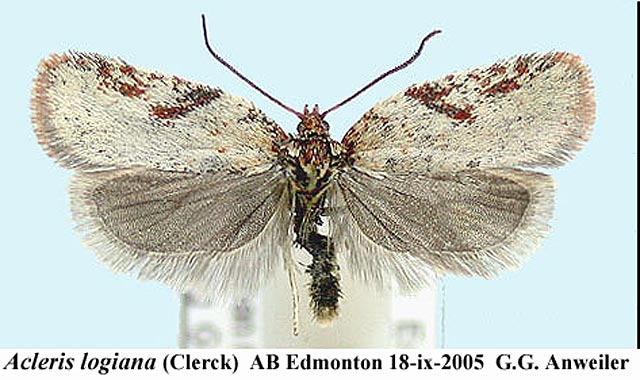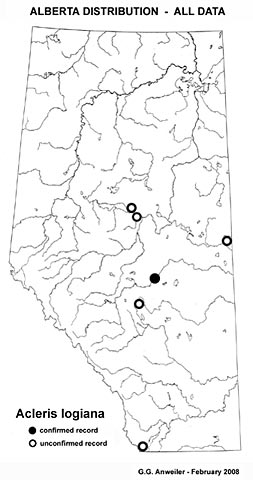Species Details
Acleris logiana
University of Alberta E.H. Strickland Entomological Museum Read more about this collection »
Common NameBlack-headed Birch Leafroller
IdentificationA small (approx. 2.0 cm wingspan) moth with whitish or pale grey squared forewings and grey hindwings. Forewing markings variable, with dark grey or rust markings indicating the inverse costal triangle – usually reduced to dark spots on the costa and in particular the dark discal dash at the apex of the "triangle". A few small spots or dots of the same color elsewhere on the forewings, in particular in the basal area. There is a series of raised white scales that form an inverse arc across the forewings when forewings when at rest. The dirty white or pale grey forewings with the few dark markings on the forewing will help distinguish this little moth.
Scientific Name
Acleris logiana
Common Name
Black-headed Birch Leafroller
Habitat
Likely occurs throughout the boreal forest, foothills and lower elevations of the mountains in AB, wherever birch is present.
Identification
A small (approx. 2.0 cm wingspan) moth with whitish or pale grey squared forewings and grey hindwings. Forewing markings variable, with dark grey or rust markings indicating the inverse costal triangle – usually…
A small (approx. 2.0 cm wingspan) moth with whitish or pale grey squared forewings and grey hindwings. Forewing markings variable, with dark grey or rust markings indicating the inverse costal triangle – usually reduced to dark spots on the costa and in particular the dark discal dash at the apex of the "triangle". A few small spots or dots of the same color elsewhere on the forewings, in particular in the basal area. There is a series of raised white scales that form an inverse arc across the forewings when forewings when at rest. The dirty white or pale grey forewings with the few dark markings on the forewing will help distinguish this little moth.
Life History
Larvae are solitary leaf-rollers. The primary hosts are birches (Betula); also recorded from Viburnum and alder (Alnus). Adults in fall (late Aug. – early Oct.) and again in spring (mid Apr. – early June),…
Larvae are solitary leaf-rollers. The primary hosts are birches (Betula); also recorded from Viburnum and alder (Alnus). Adults in fall (late Aug. – early Oct.) and again in spring (mid Apr. – early June), apparently hibernating. Adults come to light.
Range
Holarctic. Europe east across the southern USSR to Japan; widespread in the boreal forest of North America, south in the mountains in both the east and west.
Notes
One of the palest of the Acleris leafrollers, and like many members of the genus highly variable in the appearance of the adults. The adult illustrated above is a specimen from Edmonton. The genitalic illustration is…
One of the palest of the Acleris leafrollers, and like many members of the genus highly variable in the appearance of the adults. The adult illustrated above is a specimen from Edmonton. The genitalic illustration is from Razowski (1966).
References
Author
Bowman, K.
Title
An annotated list of the Lepidoptera of Alberta.
Publication Date
1951
Series Title
Canadian Journal of Zoology
Volume
29
Pages
121-165
Author
Prentice, R. M.
Title
Forest Lepidoptera of Canada. (1965)
Publication Date
1965
Volume
4
Pages
544-840
Author
Razowski, J.
Title
World Fauna of the Tortricini (Lepidoptera, Tortricidae).
Publication Date
1966
Pages
576
Specimen Information
There are 44 specimens of this Species.
BIRD28453 - Acleris logiana
University of Alberta E.H. Strickland Entomological Museum
Place CollectedCanada: Alberta, Rochon Sands Provincial Park
Collected ByBird, C. D.
Date Collected2007-04-24
BIRD35514 - Acleris logiana
University of Alberta E.H. Strickland Entomological Museum
Place CollectedCanada: Alberta, Winfield
Collected ByBird, C. D.
Date Collected2012-05-12



